Guild Wars 2 – Delving Into Microtransactions
- Updated: 30th Apr, 2012
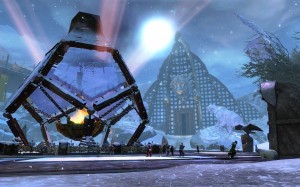 I spent a lot of time in the first public Guild Wars 2 beta this weekend and one of the things I was keen to look at was the microtransactions. Some of you might remember that the original Guild Wars was funded by expansion pack purchases. You could buy the original Guild Wars game (later repackaged as Prophecies) and play it as much or as little as you like for free. If you bought the expansion packs you got access to new areas and new character classes.
I spent a lot of time in the first public Guild Wars 2 beta this weekend and one of the things I was keen to look at was the microtransactions. Some of you might remember that the original Guild Wars was funded by expansion pack purchases. You could buy the original Guild Wars game (later repackaged as Prophecies) and play it as much or as little as you like for free. If you bought the expansion packs you got access to new areas and new character classes.
Guild Wars 2 will also be subscription-free. While we don’t yet know if expansion packs will be coming, we do know that microtransactions – small in-game purchases – will be built in from the start.
Back in March, the Executive Producer of Guild Wars 2 and President of ArenaNet Mike O’Brien wrote about this funding model on the official blog:
We think players should have the opportunity to spend money on items that provide visual distinction and offer more ways to express themselves. They should also be able to spend money on account services and on time-saving convenience items. But it’s never OK for players to buy a game and not be able to enjoy what they paid for without additional purchases, and it’s never OK for players who spend money to have an unfair advantage over players who spend time.
So how does that translate to a practical application?
There are three main forms of currency in Guild Wars 2 – gold, karma and gems. Gold is earned through quests and selling items to NPC traders. Karma is earned through world events and PvP. Gems are bought with real-world cash. O’Brien says that this separation of currencies should cut down on the goldfarmers that plague every MMO but since you can trade gems for gold on the in-game market, I’m not sure how this will help. Regardless, I’m more interested in what you can buy for your real-world monies.
I had a good poke about in the Gem Store to find out what was available. Since this was the first public beta, no real-money prices can be confirmed. I also can’t guarantee that all the items I saw will make it into the final game but since everything I tried was fully-functional it’s probably safe to assume that these items will be available in some form.
The in-game Gem store was separated into a number of categories:
- Minis
- Account
- Boosts
- Support
- Consumable
- Style
Minis:
This contained a single item – a pack that will give your character three mini-pets. Mini-pets are scaled-down versions of in-game monsters and characters, no higher than a Norn’s knee. They don’t get involved in combat but instead will scurry about looking adorable and messing up people’s framerates.
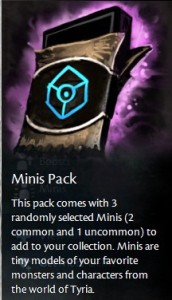 Each pack contains two common and one uncommon pet. I got lucky with my first pack and scored a fantastic flying imp. There were also a few mini human NPCs who were kinda cute but it’s very difficult to appreciate the details on such a small model.
Each pack contains two common and one uncommon pet. I got lucky with my first pack and scored a fantastic flying imp. There were also a few mini human NPCs who were kinda cute but it’s very difficult to appreciate the details on such a small model.
Account:
This held two items, “Unlock bag slot” and “Unlock bank tab”. Both are storage expansions which would be great for crafters and hoarders. Given that the combat system encourages carrying multiple weapons and town clothes (cosmetic non-armour clothing) seem to take up a slot per item, I really hope there are ways to unlock these with in-game gold or quests as well.
Boosts:
This is where things get interesting. O’Brien clearly said above that “it’s never OK for players who spend money to have an unfair advantage over players who spend time.” The boosts available were:
- Magic Find Boost – Improve your chances to get rare items by 50% for one hour
- Killstreak Experience boost – Gain an extra 100% experience from kills for 30 seconds. Time remaining is reset with each kill. How long can you keep it going?
- Crafting Boost – Improves your chance to score bonus experience from crafting items by 50% for one hour
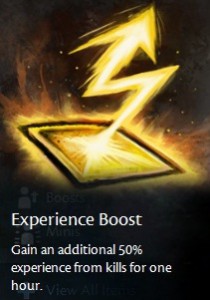
- Experience Boost – Gain an extra 50% experience from kills for one hour
- Karma Boost – Earn an additional 50% Karma each time you earn Karma for one hour
While you’re not outright buying levels or XP, these do give a distinct character and equipment advantage to players who are willing to spend more money.
I didn’t buy any of them so I can’t tell you if the Killstreak and Experience boosts are stackable. I can definitely see Killstreak adding an extra challenge to the more zergy world events like the Tar Elementals.
Support:
These were practical items that save you time, gold or both.
- Asuran Bank Portal – Each portal allows you to access your bank from anywhere once.
- Instant Repair Canister – Each canister fully repairs your items without the need of a repair merchant. This item cannot be used while in a dungeon.
- Perfect Salvage Kit – This kit is guaranteed to remove upgrades from any sort of armor, weapon or trinket and give the best chance of quality material returns.
- Resurrection Orb – Revives your character from death slowly. This item cannot be used in World vs World or PvP.
Consumable:
Occasionally, mobs will drop Mystic Chests. These can be opened with a Mystic Key, which can be purchased through the Gem Store. Presumably you can also trade the mystic chests to other players. I had one drop but my inventory was wiped before I could try to open it.
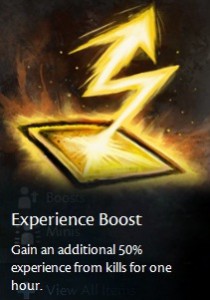 This section also included a dye pack (two common and one uncommon dye). With colour playing a big part in the basic identity of each race, there will be a lot of dyes.
This section also included a dye pack (two common and one uncommon dye). With colour playing a big part in the basic identity of each race, there will be a lot of dyes.
I’ve seen names like Peanut Butter and Walnut so if you’re hoping that buying packs will be a way to get a good range… I really hope you don’t spend loads of money only to get 19 varieties of light green. Opening the dye pack did reveal items that I had to use in order to unlock the colours, so these may be tradeable as well. Once unlocked, dyes will be available across all characters in your account.
The final consumable available for purchase was Magic Plant Food. Some mobs will drop colorful seeds. The plant food will grow these into dye plants, which should save you taking the seeds to a gardening NPC, or whatever timesink you’re supposed to do with them.
Style:
This section is where I start to fear for my wallet. I mentioned town clothes in the Accounts bit above. Town clothes are purely cosmetic outfits, if you don’t want to wear your armour while crafting or doing other sociable things around the more civilised areas. They’ll disable your weapon skills while you wear them. I’ve heard reports that you’ll automatically switch back to your armour, should you forget to swap outfits when heading back to the more dangers parts of Tyria.
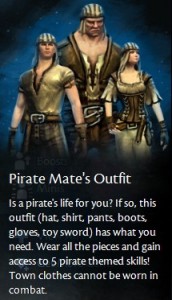 In the store I saw a Carnival Ringmaster’s Hat, a Cook’s Outfit, A Scholar’s Outfit and a Pirate Mate’s Outfit. The latter even comes with piratey-themed skills. I can easily see myself accidentally spending all my gems on silly outfits to pose about wearing in town.
In the store I saw a Carnival Ringmaster’s Hat, a Cook’s Outfit, A Scholar’s Outfit and a Pirate Mate’s Outfit. The latter even comes with piratey-themed skills. I can easily see myself accidentally spending all my gems on silly outfits to pose about wearing in town.
There were also two varieties of Transmutation Stone, which allow you to combine the appearance of one item with the attributes of another. Useful if you like the style of a piece of cloth armour but want the protection of plate mail. The normal stone is slightly cheaper and can be used on items up to level 79 and the Fine Transmutation Stone will work on all items. Presumably this higher price is there to combat (price-gouge?) the PvP technique of gauging armour weaknesses by recognising the armour models.
Do you think you’re likely to spend your hard-earned cash on any of this lot? Are you bothered by the sale of experience boosts for crafting and levelling?
Guild Wars 2 is available for pre-purchase from Zavvi, Amazon, Play or the Guild Wars 2 website.

One Comment